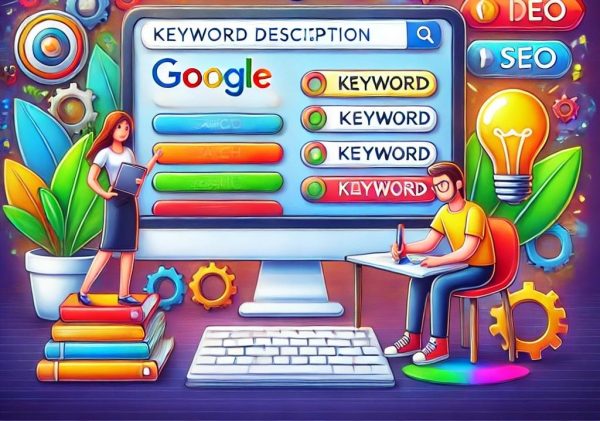It is a challenge to give a product an exact description effectively; what if you make backpacks that are also parachutes? We will describe the advantages of SEO-optimized product descriptions, offer guidance on crafting SEO-friendly descriptions, avoiding common pitfalls, monitoring performance, and other valuable insights.
E-commerce Product Description SEO

What is E-commerce Product Description SEO?
E-commerce product Description SEO is the optimization of online store product descriptions to improve their visibility on search engines. Well-optimized product descriptions make it easier for users to find them in online searches and align with your site’s overall SEO strategies.
Keyword research is something you must do to identify the terms and phrases your target audience uses to search for products. Incorporate the keywords into your product descriptions to affect your website’s visibility and improve user experience.
Why is E-commerce Product Description SEO Important?
E-commerce Product Description SEO directly impacts your online store’s visibility on search engine results pages (SERPs), influencing conversion rates, organic traffic, and overall sales performance.
Well-optimized product descriptions with relevant keywords are more likely to appear at the top of search results and attract potential customers. Optimized metadata makes search engines understand your product content and assists users in deciding to click through to your website.
Importance of Product Descriptions
- Decision Making: 87% of online shoppers consider product descriptions essential when buying.
- Impact on Returns: 64% of consumers have returned an online purchase due to an inaccurate product description.
- Boost in Conversion Rates: Well-written and accurate product descriptions affect up to 78% of conversion rates.
- Consumer Behavior: 76% of consumers seek product descriptions when viewing products online, ranking them just behind reviews and images.
- Influence on First Impressions: 95% of users look to online reviews and product descriptions to learn more about a product before purchasing.
Poor Product Descriptions
- Cart Abandonment: 30% of shoppers abandon carts due to poor product descriptions.
- Page Exit Rates: Around 70% of people leave a product page when the product description is poor or incomplete.
- Customer Inquiries: 53% of online shoppers give up on buying if they can’t get a quick question answered.
- Trust Issues: 35% of consumers say they would not buy from a brand with poor-quality product descriptions, directly impacting brand trust.
SEO and Visibility
- Organic Search Traffic: Most visitors arrive at the Top 1000 e-commerce stores through organic search, emphasizing the importance of optimizing for search engines.
- Click-Through Rates (CTR): The average CTR for the first position in search results is approximately 45.44%, higher than the second at about 17%.
- Ranking Factors: Approximately 70% of marketers say that SEO is better than pay-per-click advertising for generating sales.
- Search Engine Trust: Websites that appear on the first page of Google receive over 90% of all search traffic, making SEO optimization vital for visibility.
Best Practices for SEO Product Descriptions
- Keyword Usage: Targeting the right SEO product keywords is important for improving search engine rankings and driving organic traffic. Long-tail keywords often have a conversion rate up to 2.5 times higher than short-tail keywords.
- Length of Descriptions: Writing between 300 to 500 words for product descriptions is often considered optimal for SEO, providing enough detail without overwhelming the reader. However, descriptions under 300 words may miss out on valuable keyword opportunities.
- Meta Descriptions Impact: A compelling meta description increases click-through rates by up to 5.8%, making it necessary for improving visibility in search results.

What are the Benefits of Optimizing Product Descriptions for SEO?
Optimizing product descriptions for SEO offers several benefits:
- search engine visibility
- higher conversion rates
- effective communication of a product’s unique selling points
- specific features of the product to the target audience
- boost a company website’s search engine ranking
- product visibility for potential customers
❗Our previous experience shows:
Detailed product descriptions improve the overall user experience by offering valuable information to potential customers. When properly optimized, eCommerce product descriptions distinguish a company’s products from competitors in a fiercely competitive online market, ultimately driving sales growth and business expansion.
How to Create SEO-Friendly Product Descriptions?
- Determine target keywords: SEO-friendly product descriptions should target keywords that potential customers will likely use when searching for the product. The keywords should seamlessly incorporate the description’s title, headline, and body copy.
- Optimize for user intent: Align keywords with users’ search intent. Include terms such as “benefits” or “features” to match user search behavior and intent.
- Include product specifications: In both the body copy and product specifications section, provide detailed information about the product, including features, benefits, size, weight, and other relevant details.
- Use the inverted pyramid structure: Organize product descriptions with the most important information first, followed by additional details and background information. If you structure your description as such it will improve readability and SEO effectiveness.
- Write in an active voice: Describe the product’s functions and benefits in an active voice to improve readability and SEO performance.
- Add a clear call to action: Include a prominent call to action that guides the reader through the next steps after reading the product description.
- Rework titles and meta descriptions: Optimize the title tag and meta description with relevant keywords to attract clicks and effectively engage searchers.
- Implement schema markup: Improve search engine results by incorporating schema markup in your website’s code to provide more detailed information to search engines.
- Use bullet points for web product descriptions: Format product descriptions with bullet points for better readability and user engagement, especially for online content.
Even though what we say sounds easy and straightforward, mastering the steps takes time and effort. We recommend hiring an SEO expert to give you the knowledge and advice you need to reach a level of comfort where all of the above becomes child’s play.
The button will redirect you to the Upwork freelance platform, where you can schedule 30-minute consultations for $30 or 1-hour consultations for $60.

1. Identify Relevant Keywords
- The first step in creating effective product descriptions is identifying relevant keywords. It means understanding search intent and researching specific product attributes that potential customers are likely to use in their searches.
- Identify relevant keywords to align them with the search intent of your products to reach the right audience.
- Analyze search trends and user behavior for insight into the language and phrases used by individuals interested in products similar to yours.
- Understand your product attributes to your target audience to craft compelling descriptions highlighting the unique benefits and solutions offered by your product.
2. Use Keywords Naturally in Product Descriptions
One effective approach to seamlessly integrating keywords in product descriptions is strategically placing them within the text, focusing on weaving them into the narrative rather than forcing them.
Additionally, incorporating various keyword variations and long-tail phrases diversifies the language used in the descriptions, promoting a more nuanced SEO optimization strategy.
3. Optimize Meta Descriptions and Titles
Optimizing meta descriptions and titles increases click-through rates from search engine results pages (SERPs) and improves overall SEO performance. The quality of meta descriptions and title tags influences how your site is perceived in search results.
A well-crafted meta description summarizes your webpage, luring users to click through by previewing the content. Conversely, title tags are the initial point of contact for users in SERPs, capturing attention and conveying the relevance of your page.
4. Utilize Bullet Points and Subheadings
- Bullet points and subheadings in product descriptions break up text and provide an easy-to-read format for highlighting a product’s most important features and benefits.
- A study published in Frontiers in Psychology found that online shoppers use subheadings and bullet points to get answers to their questions quickly.
- Bullet points break up complex information into smaller, structured pieces that are easy to read and digest viewable at a glance.
- Subheadings guide users to where they will find the information they are looking for within the content itself.
- Such a system increases the likelihood of users engaging with content and getting the information they need to make informed purchase decisions.
5. Include High-Quality Images and Videos
!!!Pro-tip, very important:
Provide visually appealing content so potential customers better understand the features and benefits of a product.
To optimize images for SEO, use descriptive filenames and alt text, compress large files to improve page loading times, and utilize product videos that demonstrate product usage or showcase products in action.

What are the Common Mistakes to Avoid in E-commerce Product Description SEO?
To maintain a strong search engine ranking and drive traffic and conversions, avoid common mistakes in e-commerce product description SEO.
1. Keyword Stuffing
Keyword stuffing negatively impacts the keyword density of a product description by making the content less readable and relevant. It diminishes the user experience, as the content may seem unnatural and unhelpful.
A density of 1-2% is generally recommended to maintain an optimal keyword density and guarantee the seamless integration of keywords.
!!!Remember:
Strike a balance between SEO optimization and user-friendly content will achieve success in both aspects.
2. Duplicate Content
Using duplicate content, such as the same product descriptions for multiple pages, impedes SEO ranking progress and diminishes the uniqueness of your unique selling proposition.
Tailoring descriptions to emphasize specific features, benefits, and targeted keywords boosts SEO ranking and offers valuable and distinctive information that sets your product apart from competitors. Employing storytelling is a powerful method to achieve it, and integrating user-generated content or reviews as social proof to foster trust with your audience.
3. Not Optimizing for Mobile
Insufficient mobile product description optimization has negative impacts, such as poor user experiences, increased bounce rates, and missed sales opportunities. With up to 80% of online traffic from mobile devices, prioritize website optimization for mobile users. Vital elements for a mobile-friendly experience include achieving a fully responsive design, optimizing images and videos for quicker loading times, and simplifying navigation for mobile users.

How to Measure the Success of E-commerce Product Description SEO?
The success of your e-commerce product description SEO is measured by metrics such as keyword rankings, organic traffic, and user engagement.
1. Monitor Keyword Rankings
Monitoring keyword rankings is important to determine the effectiveness of product descriptions in search engine results and to uncover optimization opportunities. Businesses utilize tools such as Google Analytics, SEMrush, and Moz to track the performance of specific keywords, analyze trends over time, and identify patterns.
Adapting SEO strategies based on ranking data allows businesses to remain competitive and progressively improve their search engine visibility.
2. Track Organic Traffic and Conversions
Track organic traffic and conversions to assess the effectiveness of your SEO strategies in attracting a consistent stream of visitors to your online store and converting them into customers.
Analyze organic search metrics such as website traffic sources, popular keywords, and user behavior to gain valuable insights into how users discover and engage with your site.
Tools such as Google Analytics, SEMrush, or Moz provide data on traffic patterns, conversion rates, and user engagement, allowing you to measure the impact of your SEO initiatives and make informed decisions about optimizing your site further.
3. Analyze User Engagement Metrics
User engagement metrics, such as time on page, bounce rate, and customer reviews, offer valuable insights into user interactions with product descriptions and the effectiveness of the content. Analyze the metrics to evaluate which aspects of the product descriptions positively engage customers and pinpoint areas that require improvement.
Proactively listening to customer feedback aids businesses in identifying pain points, preferences, and areas of satisfaction, which are utilized to optimize product descriptions to align better with customer expectations and preferences.

Frequently Asked Questions
What is E-commerce Product Description SEO?
E-commerce Product Description SEO refers to the process of optimizing product descriptions on an online retail website for better search engine visibility and rankings.
Why is E-commerce Product Description SEO important for online retailers?
E-commerce Product Description SEO is important because it allows online retailers to attract potential customers, increase website traffic, and improve sales and revenue.
How does E-commerce Product Description SEO work?
E-commerce Product Description SEO incorporates relevant keywords and phrases into product descriptions, optimizes image alt tags, and improves overall website structure and navigation.
What are some best practices for E-commerce Product Description SEO?
Some best practices for E-commerce Product Description SEO include using unique and descriptive product titles, incorporating long-tail keywords, providing detailed and accurate product information, and optimizing for mobile devices.
How does SEO impact conversion rates for e-commerce product descriptions?
E-commerce Product Description SEO impacts conversion rates by providing potential customers with valuable information and persuasive language in product descriptions, ultimately convincing them to make a purchase.
Are there any tools available for Ecommerce Product Description SEO?
Yes, there are various tools available for Ecommerce Product Description SEO, such as keyword research tools, SEO analysis tools, and content optimization tools.

